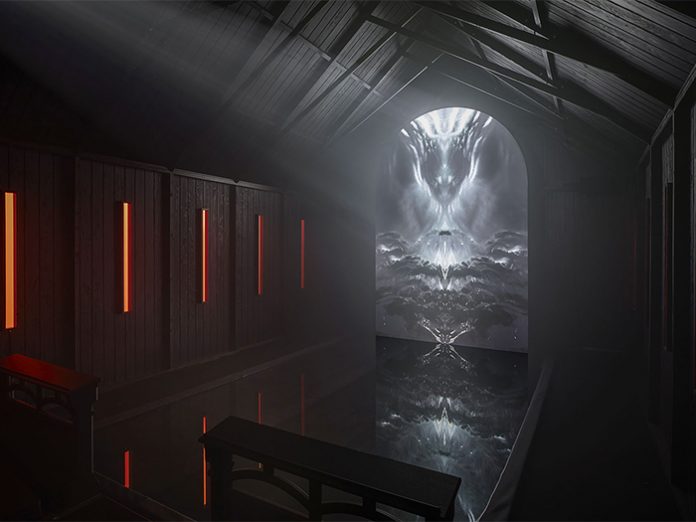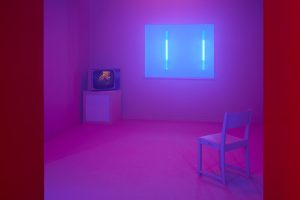
Astera LED Titan Tubes were at the heart of a lighting scheme designed by Ben Donoghue, now of Flare Lighting, for Beyond the Road: an immersive exhibition at London’s world-famous Saatchi Gallery last year.
Featuring the music of UNKLE, the experience thoughtfully and cerebrally merged the worlds of visual arts, music and film, offering visitors a chance to lose themselves in a multi-sensory world led by sound. In the watchful eye of UNKLE’s James Lavelle, the work was curated by Creative Producer, Colin Nightingale and Sound Designer/Creative Director, Stephen Dobbie of Punchdrunk.
Lighting Designer, Ben Donoghue – who has recently joined Ben Cash, David Amos and the team at Flare Lighting from Imagination – has worked regularly with Nightingale and Dobbie and was asked to collaborate on the project to create a lighting design for the experience which ran for 12 weeks.
Dobbie, along with Sound Designer Salvador Garza Fishburn, deconstructed the last two UNKLE albums, The Road: Part 1 and The Road: Part II / Lost Highway, re-arranging and re-interpreting the work within a curated environment featuring a range of artistic and filmic works. Featuring contributions from artists including Danny Boyle, Jonas Burgert, Alfonso Cuarón, Toby Dye, Doug Foster, Norbert Schoerner, Warren Du Preez & Nick Thornton Jones ranged from painting to film, sculpture to photography, tracing influences in Lavelle’s work.
Beyond the Road took over the entire top floor of the Saatchi Gallery. Visitors flowed through a series of interconnected spaces, exploring the constantly evolving soundscape and visual cues. A central hub of smaller rooms and corridors served to break any sense of linearity to the piece, encouraging visitors to choose their own path.
A quantity of Astera LED Titan Tubes were deployed here, supplied by Flare Lighting, ro reference the linear architectural form of a conventional interior fluorescent fitting that one might expect to see in an ordinary gallery setting. “Pulling fixtures down out of their usual ceiling rigging and into audience eyeline and introducing very carefully crafted colour, pixel and dim effects served to abstract a collection of ostensibly domestic spaces and help visually propel visitors around this transitory space,” said Donoghue. “Just as the music had been deconstructed, so too were the architectural conventions of the gallery and exhibition space; blank walls and ceilings became canvases for bold washes of colour.”
The artwork in this central zone was itself warped and animated by the lit environment; the usual soft white spotlighting making way for trippy, and at times unsettling, saturated lighting treatments, thus uniting the disparate visual elements. The interaction of coloured light and painted finishes created some extraordinarily vivid transformations. Notably, in mirroring rooms painted green-screen green and hot pink respectively, certain moments and colour contrasts achieved real intensity, emphasising movements in the swirling soundtrack.

Donoghue explained: “In part, I wanted the lighting fixtures, including the Titan Tubes, to play an active part in the overall sensory experience. Rather than remaining purely incidental or an element to be ignored by the gallery-goer, as would be the case in one’s usual art gallery visit, here the fixtures were very present, as much so as the artwork itself; at once atmospheric and architectural.” He continued: “Themes of deconstruction and abstraction were at the heart of the project and Titan Tubes, both because of their physical form factor and their pixel control, were an ideal tool to help tell this story and set the visual language for this key dynamic area of the exhibition.”
The Astera LED Titan Tubes were run in four-pixel mode as Ben especially liked the blocky, almost analogue look that this achieves, which was right for the piece. By employing contrasting half-and-half or quartered split-colour combinations, they created a really bold language and identity for this space that felt engaging and unique to Beyond The Road. The Astera LED Titan Tubes offered up to 16-pixel control. “I think by self-imposing the constraints of a more limited pixel count to work within, we created a much stronger look for the show than might have been afforded by a more flexible approach.”
The full installation – including set build, sound, lighting and video installs – was completed over a one-week period. A further two weeks were scheduled for sound creation and arranging in the near-completed space, along with lighting and video programming and gradual installation of all the individual artworks. “Developing the show was a truly collaborative process, with each discipline informing the other,” Donoghue remarked. “We put in a toolkit that I knew would achieve certain key looks and then the piece gradually developed in the space through lots of conversation, responding to new stems, new arrangements and new artwork arriving.”
Due to the 12-week run of the exhibition and its 8-hour daily operation with limited power-up/power-down time at the top and tail of a show day, it was necessary that the Astera LED Titan Tubes remained wired in situ. All control was neatly boxed in with all wiring concealed in painted trunking. Donoghue recalls that they needed a reliable wired system and the Astera LED PowerBox offered just that.
Although familiar with Astera LED Titan Tubes, controlling them wirelessly, however, was new to Donoghue, he used them ‘plugged’ and networked over sACN. “There were no issues over the run and none of the tubes needed swapping out, which was great.”





